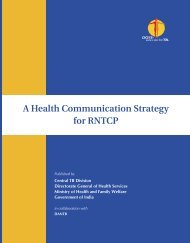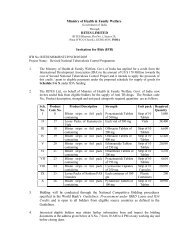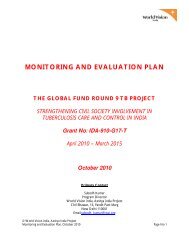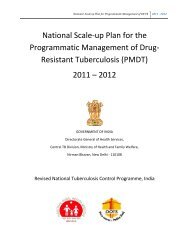RNTCP Annual Report 2012 - TBC India
RNTCP Annual Report 2012 - TBC India
RNTCP Annual Report 2012 - TBC India
Create successful ePaper yourself
Turn your PDF publications into a flip-book with our unique Google optimized e-Paper software.
Human Resource Development<br />
The ultimate goal of HRD for comprehensive TB control<br />
is to have the right number of people, with the right<br />
skills, in the right place, at the right time, who are motivated<br />
and supported to provide the right services to the<br />
right people.<br />
Vision: A world where every person, everywhere has<br />
access to a motivated and supported health worker, who<br />
is skilled in TB control.<br />
Goal: Health workers at different levels of the health<br />
system have the skills, knowledge, and attitudes (professional<br />
competence) necessary to successfully implement<br />
and sustain comprehensive TB control services based on<br />
the Stop TB Strategy.<br />
A sufficient number of health workers of all categories<br />
involved in comprehensive TB control is available at all<br />
levels of the health system with the needed support systems<br />
to motivate staff to use their competencies to provide<br />
quality preventive and curative TB services for the<br />
entire population according to their needs.<br />
Committed, qualified and trained health care providers<br />
equitably distributed at all levels are the foundation of an<br />
effective health system specifically in the context of TB<br />
since DOTS is human resource intensive and requires a<br />
strong patient-provider bond and extensive supervision<br />
and monitoring.<br />
The main thrust of the <strong>RNTCP</strong> was the provision of<br />
diagnostic and treatment facilities at the peripheries of<br />
the district and the creation of a sub-district level supervisory<br />
unit, which would also provide diagnostic and<br />
treatment services. Accordingly, and based on the TB<br />
epidemiology of the country, Designated Microscopy<br />
Centres (DMC) were set-up for every 100,000 population<br />
(for every 50,000 population in tribal and hilly areas)<br />
and TB units were set up at every 500,000 population (at<br />
every 250,000 population for hilly and tribal areas).<br />
31<br />
Unprecedented programme expansion in the last five years<br />
has outpaced capacity at central, state and district level to<br />
ensure quality of services. A workload analysis done by<br />
CTD, PATH & Initiatives Inc, highlighted the human resource<br />
gaps in many cadres. Members of the staff at<br />
state and district levels have to perform multiple functions<br />
leading to increased workload and being overburdened.<br />
Rapid turnover of officials and staff also necessitates<br />
frequent trainings, which is neglected at times.<br />
In addition, enhanced case finding, treatment, MDR, TB-<br />
HIV, PPM, and ASCM activities required to achieve<br />
Universal Access over the next 5 years necessarily need a<br />
better approach to human resource development. Hence,<br />
there is an urgent need for national HRD planning that<br />
strategically and comprehensively addresses the overall<br />
staffing issues related to recruitment, capacity development,<br />
performance and retention.<br />
Key strategies for HR for TB control:<br />
� HR needs assessment<br />
� HR policy revisions<br />
� Organize on going in-service training<br />
� Initial training in all aspects of basic DOTS, TB-<br />
HIV, MDR-TB, accounts, procurement, ACSM,<br />
etc. for existing staff and new hires including<br />
private providers in TB control<br />
� Retraining for major performance problems<br />
� On the job training for small performance problems<br />
� Continued education<br />
� Advanced training on management aspects such<br />
as health financing, leadership/governance, business<br />
planning, organizational development.






